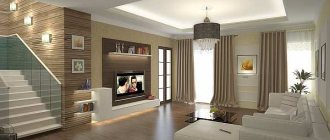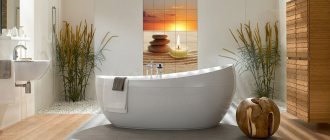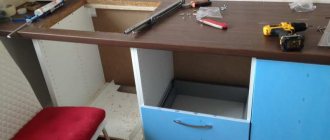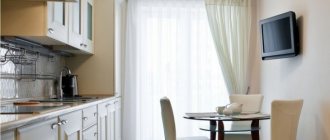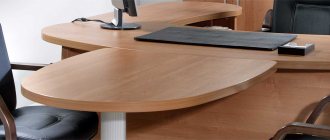The kitchen is the most important place in any home! It, like a magnet, attracts household members, reflects the habits, character traits, and material well-being of its owners. This is where you can escape from pressing problems and gather the whole family around the big table.
It is very important not only to equip this room, but also to plan it correctly. The main criteria that should be followed when organizing a kitchen space are convenience and versatility. When planning a kitchen, the main thing is to rationally distribute every centimeter so that while cooking you don’t have to bend over or reach for something. That’s why when buying kitchen furniture you should take into account not only the material and color scheme, but also its dimensions.
There is no specific answer to the question of what the acceptable height of a kitchen set should be. There are kitchens made both according to the dimensions indicated in GOST, and models whose dimensions are selected individually. Let's find out what the Antares store specialists think about this.
How tall are kitchens made?
Before ordering furniture for the kitchen, it is important to consider the size and design features of the room. Companies that manufacture furniture most often focus on statistics and produce kitchen sets of standard dimensions. Based on this, the level of the tabletop ranges from 860-900 mm. For people with a height of 158 cm to 172 cm, this is quite enough.
If the height of the owners differs significantly, they think about an individual project. Then the furniture is made taking into account the client’s wishes and fits into non-standard or small-sized rooms.
To make it easy and pleasant to work at the work surface, its height should be slightly below waist level. The dimensions of kitchen furniture are determined taking into account the height of the person who usually prepares food for the family. It is not difficult to calculate the optimal countertop height in the kitchen:
- you need to stand with your back straight;
- bend your arm at the elbow;
- the acceptable height of the working plane will be 3-4 cm below the elbow;
- It is advisable to place the hob 5-6 cm below the elbow so that splashes of hot oil do not get directly into the face;
- For working with dough and kneading products, it is better to choose low-level surfaces. Because during these processes you need to apply physical force, it will be easier to do this if the movements are directed from top to bottom.
Physiological comfort
Most work in the kitchen is done while standing. In this case, the load falls on the spine, its vertebrae, and intervertebral discs. When tilting, even slightly, tension in the muscles of the back, neck, and lower back increases.
For a healthy person this leads to rapid fatigue, but for a back patient this is generally a big problem. Therefore, the height of the tabletop should minimize tilting.
Work surface with different levels
Consumers are increasingly choosing multi-level countertops. It is not only beautiful and convenient, but also very practical:
- during long cooking, the housewife does not feel tired, since the muscles of the buttocks, arms, and back experience insignificant tension;
- the working surface is divided into several functional zones, which greatly simplifies cleaning;
- You can harmoniously and practically play around with a non-standard shaped room, increasing the usable space, integrating surfaces into niches or free corners, behind which it is convenient and comfortable to work.
The upper tier is positioned so that you can reach the second shelf without standing on your toes. It is important to take into account the distance from the lower tier to the cabinets located above. It should be at least 450 mm, which will allow you to arrange household appliances and kitchen appliances with utmost convenience. The acceptable distance between the floor and hanging tiers is 550-600 mm, taking into account the fact that the kitchen will be used by people of average height.
Installation dimensions
All significant dimensions must be taken into account at the design and drawing stage. This group includes not only standard width, depth and height. The distances to communications, utility networks, and electrical wiring are also taken into account here.
All dimensions must be determined when drawing up drawings.
In order for the entire kitchen complex to work well enough, it is also necessary to take into account ergonomic indicators. This group includes:
- space for open doors of wall and floor cabinets;
- space for pull-out parts of bedside tables;
- the size of the hood installation above the stove;
- space for free movement of the doors of the refrigerator, oven, microwave oven, dishwasher.
If the dishwasher has the classic type of installation in the corner, then it is advisable to place a special shelf under it, the design of which allows the dishes to occupy all the useful space.
It is advisable to place a special cabinet under the corner sink.
Subject to installation standards, accepted project dimensions and advice from experienced professionals, your kitchen will receive excellent parameters, and you will be happy to cook in it.
What height should I make cabinets in the kitchen?
It is impossible to imagine a kitchen set without wall cabinets. They are convenient for storing dishes, cans of cereals, and other accessories and devices. The load on the upper modules is large; you not only need to ensure reliable fastening, but also figure out at what height to hang the furniture.
Specialists at the Antares store advise installing cabinets in such a way that their top edge is no more than 250 mm higher than a person’s height:
- for people about 175 cm tall, the lower shelves of the cabinet are located at a level of 1 m 50 cm from the floor;
- tall people will be comfortable using cabinets located at a height of 1 m 80 cm.
If you do not follow these rules, then you will only be able to reach the top shelves with the help of a stool. It is important to take into account not only the height, but also the age of the people who will use the kitchen set. For an elderly person, it is better to choose wall cabinets of medium height; they are also not hung high, then there will be no need to climb a ladder or stepladder, which can cause injuries.
Since the shelves located at the top are difficult to reach, they are not used often. This space is best used for storing light items.
Before determining the level for the furniture canopy, it is advisable to take into account the following nuances:
- the height of all people living in the apartment;
- height of suspended modules;
- the distance between the tabletop and the top tier;
- ceiling height;
- filling of hanging modules.
If the cabinets are placed at eye level, this will allow you to reach the desired shelf without making significant effort. It is also important to consider the location of ventilation ducts; furniture should not block access to them.
The standard height of wall cabinets is 70-90 cm. This parameter determines how functional the kitchen furniture will be. When designing a kitchen, we take into account what will be stored in the upper tier. Often, small kitchens have tall cabinets to provide more additional shelves for storage. However, you need to ensure that there is no visual overload. Too tall cabinets will make the kitchen cramped and less cozy.
A kitchen set with an upper tier reaching to the ceiling is not installed in rooms whose height is higher than 3 m. Such a design will look unnatural, and it is almost impossible to use the shelves located at the top without the help of a stepladder.
It is customary to leave 30-40 cm of free space above the hanging modules. This is done not only for aesthetic reasons, but also for practical purposes. This gap is used for air ducting, as well as to get rid of clutter and hide annoying wires (for example, from a range hood).
In those areas where large household appliances are located, the height of the cabinets may be smaller, but not less than 36-40 cm. At the request of the customer, the height of the upper tier is increased, sometimes it can reach up to 120 cm. The most important thing is that the housewife can freely reach to the bottom edge of the upper modules.
Calculation of parameters
Height is an extremely important parameter when choosing, but it is not the only one. There are a number of other important measurements that must be taken into account when planning your kitchen space.
First, depth is important. Most copies on the market are produced in strips of 3 or 5 meters and a width of 60 cm. From European manufacturers you can find wider options, approximately 70 cm.
In addition to height, the depth of the kitchen countertop is also important.
According to experts, the thickness can be different, but the market offers two standards - 28 and 38 mm. These indicators are more important for design, because the wider the tabletop, the more massive and rough it looks.
You also need to take into account the distance between the countertop and the bottom edge of the wall cabinets, especially if the owner of the kitchen is of non-standard height. As a rule, this figure is approximately 50-60 cm.
The most common countertops are 28 and 38 mm thick.
See alsoKitchen in the house: design for different layouts
What to do with built-in appliances
It is not recommended to install household appliances inside wall cabinets, so their depth is approximately half that of the lower tier. If, however, a decision is made to hide a microwave or oven inside the module, then the depth of the cabinets should be at least 40 cm. Under this condition, the appliances can be used without difficulty. In order for the equipment to cool faster and to avoid a fire hazard, the back wall of the cabinet is removed.
Sometimes the hood has to be built into a wall-mounted module, then you need to take into account the type of connection of the stove. If it is an electric oven, the hood is placed at a distance of 70-75 cm and 75-80 cm - in the case when a gas hob is used.
In order for the kitchen set to look like a single whole, the width of the fronts of the top and bottom rows must match. There is no need to make the facade too wide, because when opened it will take up a lot of space. The standard width of the facade of one kitchen door is 30-50 cm, two – 60-100 cm.
Kitchen measurements
Before you go shopping for a new headset, you need to take measurements of the existing room. Usually, when ordering furniture in a salon, such work is performed by a specialist; by the way, additional payment may be required. This is necessary if the room has a complex structure, with many niches, projections and other features. Then it is better to use the services of a professional and rest assured that no problems will arise during subsequent installation.
But if the kitchen is of a simple shape, then you can easily take the measurements yourself. Here you will need a tape measure and a sheet of paper. First of all, you should find out the distance from the floor to the ceiling and mark it on the drawing. It is also necessary to find out the width of the walls along which you plan to install the kitchen unit.
We must not forget about windows, doors and other openings and protrusions, which should be noted on the plan indicating the dimensions, as well as the direction of the doors and sashes when opening.
The last step should be to mark on the drawing all sockets, ventilation, switches, plumbing and other details. If, when designing a new kitchen, you plan to place electrical sockets and switches differently, then it is better to take care of this in advance and redo them before purchasing the set. It is best to install sockets for built-in household appliances and refrigerators at a distance of 100 mm from the floor. At the same time, it is more convenient to place them slightly away from the equipment, for example, behind a nearby cabinet. Sockets located in the apron area should be installed at a height of 900-920 mm from the floor.
Having in hand a detailed drawing indicating the dimensions and placement of sockets, switches and other parts, you can easily determine the most convenient layout of kitchen furniture. And also choose which set will be appropriate - standard or multi-level.
Working surface height
The generally accepted height of floor modules is 850 mm. However, this indicator can be adjusted if you install twist-out legs on the furniture. But most often they choose a standard base. For people whose height does not exceed 178 cm, a support with a level of 100-120 mm is suitable, then the total height of the bottom row will be 800-850 mm, working behind such a surface is pleasant and comfortable.
For a person above average height, select a base with a level of 150-200 mm, then the working surface will be at a level of 900-950 mm. For people with disabilities or those whose height is up to 150 cm, the suitable working surface height is 760 mm.
The level of the lower tier is calculated based on the following indicators:
- depth of the working area (600-700 mm). The larger it is, the wider the viewing angle and the more pleasant it is to be in the kitchen;
- the distance between the lower and upper tier. It is important to position the upper modules in such a way that you do not hit your head on them during operation;
- the optimal gap between the hob and the sink is at least 400 mm. This will prevent splashes of water and detergent from getting into the soup pot.
Keep in mind that the height of the working surface is also affected by the thickness of the table top (usually it is 3-4 cm). The table top reaches the kitchen apron; the joint is masked using a wall edge or kitchen plinth. A free space of several centimeters is left between the cabinets and the wall, which is used for laying gas and water pipes, masking wires, etc.
Tabletop connector - euro saw: hidden docking (photo)
A method of processing ends that uses patterns. To create it you need a milling machine. Only with high-quality equipment it turns out flawless.
narrow room for two boys
Sometimes euro-sawing is produced on a cutting machine - this significantly reduces the cost of production, however, with such economical production, the ends are obtained with fluctuations of a millimeter or more. Therefore, when purchasing, you should check this point very carefully, especially if the price of a prefabricated kitchen surface is significantly reduced. A poorly made joint will not connect as it should, leaving gaps.
Correctly executed ends after assembly form a surface on which the gap is not visible at all - it is there, but its width is a fraction of a millimeter. If the coating is dark in color, it will not be easy to find where the euro-cut table top was cut (photo).
Such ideal quality can only be obtained using a router, and the patterns must be new or at least not worn out.
Depth of the working area in the kitchen
Recommended tabletop depth is 600 mm. This size will allow you to easily integrate “essentials” (sink, hob, etc.). The minimum depth of drawers is 460 mm, optimal is 560-580 mm.
If the size of the room allows, the depth of the working surface can be increased to 900 mm. Then the depth of the drawers is at least 760 mm. In professional kitchens, as well as in loft-style rooms, worktops with a depth of 1200 mm look good. Such a large surface is best installed in the center of the kitchen. This is a multifunctional table (also called an island) that increases the comfort of the kitchen and allows you to conveniently move to other workspaces.
To select the ideal depth of the working area, it is necessary to take into account the length of the arms of the person who most often prepares food in the family, as well as the dimensions of built-in appliances and tabletop household appliances.
What are multi-level countertops?
In spacious kitchens, it is convenient when various important areas: the sink, the surface intended for cutting food, and the stove are located at different levels. In this case, the sink is placed higher by about 10-15 cm relative to the table, and the hob, on the contrary, is the same amount lower.
Multi-level countertops
What is it for?
- On a lower stove it is more convenient to stir the food being prepared and monitor the process in a tall pan.
- A more comfortable position of the arms and spine when washing can be ensured by a slight elevation of the washing area.
Of course, with such a design of the work area, there is a high risk of touching dishes or ready-made dishes placed on the table. But, if each plot has a larger area, it will be more convenient to work. And you can protect yourself from awkward movements by installing demarcation sides.
Built-in technology
The tendency to tie the oven to the hob is gradually becoming a thing of the past. Increasingly, this technique is being integrated at the torso level. The housewife does not need to bend low to the floor every time to check the readiness of the dish, and this is also very convenient from a safety point of view. Burns and injuries occur much less frequently.
Sometimes a washing machine is built under the countertop. Since the standard height of appliances is 850 mm, it is often necessary to increase the level of the lower base of the kitchen unit to 900-910 mm. This can be done using adjustable furniture legs or by replacing the standard 100 mm plinth with a 150 mm one. Based on this, it is worth considering that the upper modules will also rise.
It is customary to build a dishwasher into the bottom row. Its standard dimensions are 55 cm/60 cm/82 cm, so it fits under the tabletop without any problems.
Marking and milling of drywall
First, we measure the dimensions of the future countertop by laying out the tiles on some plane. Don't forget to take into account the seams between the tiles. We reconfigure the router to work with 15 mm thick drywall.
insulation of the external wall of a brick house
We make a test pass and, making sure that everything is in order, we begin making the tabletop.
We make three passes on each side in order to simulate the thickness of the countertop, and the thickness of this countertop will be a multiple of three small mosaic tiles.
Our vacuum cleaner does not cope well when milling such thick drywall, so we had to work in respirators. We remove the corner elements and cut out the embed so that later we have something to attach the legs to.
We make the embedment from 20 mm plywood, although 12 mm would be perfect, I just happened to have 20 mm on hand at that time. Next, we cut the corners at 45° with a hacksaw, bend them and get a rigid and perfectly even blank for our future tabletop:
Polyurethane foam is excellent for gluing such parts.
Optimal sizes
In order to choose the optimal size dining table, you must first decide what the tabletop will be used for.
It is also important to consider the area of space allocated for the product
There are average tabletop parameters for different sizes of the dining area. The countertop for a small kitchen area that is not designed for a large number of guests should be 90x60 cm and 80x60 cm. If the dining space of the room has an area of about 10 square meters. m, then a table with dimensions of 110x70 cm, 120x80 cm is perfect for the space.
Folding models will fit well into a small kitchen. When assembled, the optimal size of the table is 80x30 cm. For large kitchen-living rooms, models longer than 180 cm are suitable. However, it should be remembered that such a set looks very massive.
The height for the dining model is 90 cm. This is the optimal size, designed to ensure that the knees of the person sitting at the table do not touch the inner surface of the base of the product.
The optimal parameters for a dining table also depend on the shape of the tabletop. Let's look at each of them.
Rectangular
The model is considered a classic option. The tabletop can take up any space in the room. A rectangular tabletop can be placed against a wall, in the middle of the dining area or in a corner. This type of furniture does not hide the work space and is convenient for accommodating guests. The dimensions of the rectangular model for 6 people are 150x190 cm, for 8 people - 200x110 cm, for 10 people - 260x110 cm, table for 12 people - 320x110 cm.
The optimal distance between the dining table and other furniture is 1 m. It is also worth considering the convenience of moving chairs away.
Square and triangular
The universal model allows you to save kitchen space. Such furniture is considered unique for any area. The average size of square tables is 90x60 cm. Models with a width of more than 90 cm look massive and take up a lot of space.
Triangular-shaped models are an innovation in the manufacture of dining furniture. The new-fangled option will fit into kitchens designed in high-tech, modern or minimalist styles. The shape of the table allows for seating up to 3 people. The size of the triangular model for the dining area should occupy no more than 1 square meter. m area. In this case, the length of the side is 80-90 cm.
Round
The original round tabletop is considered the safest option due to the absence of sharp corners. Round models have one leg or a support in the form of four legs.
Models with one support allow you to place at least 4 people at the table. In this case, nothing will interfere with placing your feet under the table. The round tabletop option with legs has limited space under the table. The round model with four legs takes up a lot of space.
Among the disadvantages of a round tabletop, it is also worth noting the inconvenience of location - the model cannot be moved to the wall. Round products have one size - diameter. Small dining tabletops for 4 people have a size of 110 cm, for 6 people - 130 cm, for 8-10 people - 150-170 cm.
Oval and semicircular
The oval shape is most in demand. Seating at such a table requires more people than when seating at a square model.
The standard width of the round-shaped model is 1 m. The length is calculated based on the number of people. If you need to place from 4 to 6 people at the table, a model with a length of 150 cm is suitable, for 8 people - 180 cm, and for 10 people - 210 cm.
The semicircular table is also considered a leader in ease of use. One side of it can be moved towards the wall, which will save space in the kitchen work area. At the same time, a large family can comfortably sit behind a semicircular tabletop.
If the height does not fit into GOST
The dining table should be comfortable for the whole family. This is an axiom that does not require proof. But achieving harmony is not easy - mass-produced furniture may not be suitable.
The comfortable height of the dining table directly depends on the level of the chair and the parameters of the person.
The height of the table from floor to tabletop is designed for a person of average height - 1.65 m. According to the requirements of GOST 13025.3-85 for furniture, the standard height of a dining table is 0.72-0.78 m.
When choosing a dining room set, it is necessary to take into account the height of all adult family members.
If this is not enough, then the height of the dining table is calculated using the formula:
V=Рср*ВГОСТ/РСТ,
B – calculated table height,
RSR – average height of adult family members,
VGOST – table height according to GOST – 750 mm,
PCT – the average height of an adult is 1650 mm.
For comparison, in public canteens and snack bars the standard height is 65 cm.
If you have a large kitchen, then a square table is best.
The average height of your family members is determined by the arithmetic mean. According to this formula, the main ranges for the dining table are calculated:
- Short people (up to 1.5 m) – 0.75-0.77 m;
- Below average height (1.5-1.65 m) – 0.8-0.83 m;
- Standard value according to GOST (1.65-1.8 m) – 0.85-0.9 m;
- For tall ones (above 1.8 m) – from 1 m.
The kitchen table is the center of the dining area. It must satisfy the needs of those who live in the house and those who come to visit.
Any family gathers once every six months for a family celebration. The festive table must satisfy the following conditions:
- One person should occupy at least 0.5 m of the perimeter of the tabletop;
- Select the height of the table in accordance with the above formula, width - no less than 0.65 m;
This is how it is in Europe and Russia - it is customary to sit on a chair at the table.
The standard height of a kitchen chair means the height from the floor to the seat is 40-45 cm.
It should have a comfortable backrest and a comfortable seat height for a person, approximately equal to one-fourth of the average height of adult family members. With a height of 1.8 m, its height will be 0.45 m.
The optimal seat depth is 40-45 cm (the seat should not dig under the knees). A person of average height will be comfortable sitting at a table with a height of 74 cm.
People of different heights come to visit and it is impossible to guess the size of the chair in advance. Invest in one or two chairs with adjustable seat heights and footrests for such occasions.
Remember that the standard height of a dining table according to GOST is “adjusted” to a person 165 cm tall.
Modifications
Children's furniture for children from 2 years old is distinguished by a variety of shapes, configurations and sizes.
There are several most common types of children's tables.
Let's look at each model in more detail:
- Table transformer.
Most often it is made of natural wood or plastic panels. You can use the structure immediately after your child learns to sit and walk. The kit will help you adjust the height individually to suit your baby. The tabletop, as a rule, can be adjusted in height or fixed at an angle. It is best to give preference to a product with a smoothly changing height. The table and chair will “grow” with your child. - Children's feeding tables.
Such furniture is necessary if you have a small child in the house. Over time, you can detach the high chair and use the table for fun board games. - If the children's room has a small area, give preference to folding models. Such furniture can be easily removed by leaning it against the wall, thereby freeing up space.
Transformable feeding set
Standard
Manufacturers of kitchen furniture are guided by two basic principles - versatility and ergonomics of the product, without forgetting, of course, about design.
The calculation of the standard height of a kitchen set takes into account the frequency of the main directions of human movement in the room, the possibility of placing furniture in such a way as to minimize the waste of time and energy on necessary actions.
European parameters are calculated for housewives whose height is one meter 65 centimeters. Manufacturers also provide for the fact that built-in appliances fit seamlessly into standard furniture.
Atypical option
The standard layout of a kitchen set with a countertop that matches the height of other furniture elements is not always the most comfortable for work. An unusual headset configuration with different heights from the floor can make the room ergonomic and the interior original.
A good solution would be to combine higher countertops with the height of the dishwasher, and a low table will fit perfectly into the composition of the hob.
Corner models
This type of furniture placement comes in several forms:
- L-shaped;
- in the form of a trapezoid;
- similar to the Latin letter V.
The length of the rear walls can reach up to 60 centimeters if the interior design is trapezoidal. The width of the front sections is from 38 to forty centimeters.
The V-shaped placement of furniture provides for the length of the rear walls to be up to 80 centimeters, while the width of the facades of floor cabinets is up to 50 centimeters, and wall cabinets up to thirty.
In L-shaped kitchens, the most traditional placement of furniture is the design of a working triangle.
When placing furniture in corners, the height of the kitchen unit usually coincides with the standard dimensions.

